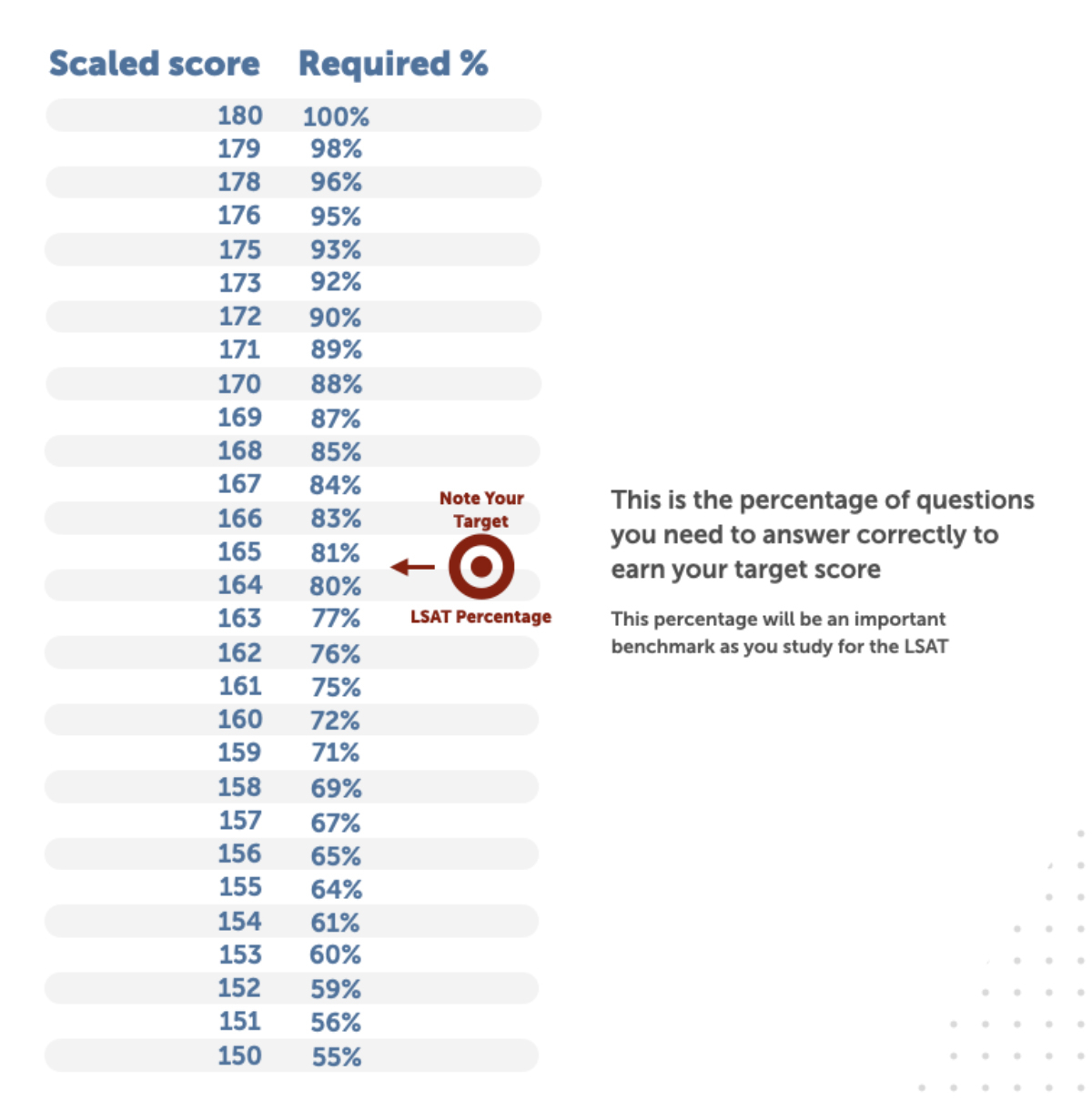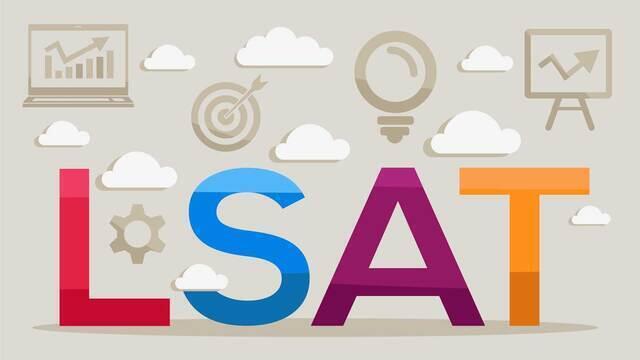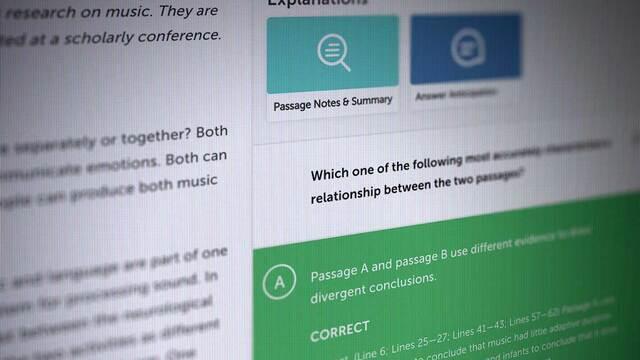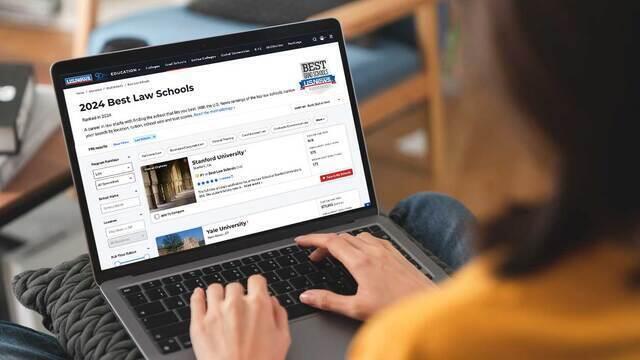Let's imagine a hypothetical: By some twist of cosmic fate, an NBA team has selected both you and your close friend to participate in a halftime competition. During this competition, you and your friend will have 60 seconds to hit as many three-point shots as you can.
This NBA team knows you and your friend are both applying to law school this fall, so the team navigated the considerable red tape to work out a deal with the admissions departments of some of the nation's top law schools (just go with us on this part of the hypothetical): if you hit a certain number of three-pointers — I don't know, let's say 10 — you'll get to attend one these law schools. If you hit an even-higher number of threes — let's say 15— you'll even get a robust scholarship.
Unfortunately, neither you nor your friend has much experience shooting three-pointers. And a three-point shot is not easy — you're trying to toss a 10-inch diameter leather ball into an 18-inch diameter metal rim 10 feet high and 22 feet away. You haven't played basketball since you were a little kid and haven't paid much attention to it since. You're trying to go to law school — you didn't major in Basketball Studies or anything like that. But you have a few months to prepare for this halftime competition. You have plenty of time — a no shortage of basketballs or hoops — to prepare for this three-point competition.
So, what's the plan? Your friend heard that 60-second part and thought, "That's not much time." Your friend practices shooting as fast as they can. Never mind where those shots may land, your friend figures. If they can let those shots really fly, at least ten of them are bound to land in that 18-inch hoop.
You, on the other hand, figure that it makes more sense to get better at shooting a basketball. Rather than your friend's spray-and-pray strategy, you decide to make every shot count. You work on your shooting form — perhaps under the tutelage of a knowledgeable coach — and work to improve your accuracy. You figure you can get about 30 good shots off in a minute. If you can get to a point where you can comfortably hit 30 to 50% of your three-point shots, you have a pretty good chance at getting this still-kinda-hard-to-believe backdoor law school admissions. Maybe you can even get a little lucky and earn that scholarship.
We'll tie this overextended analogy up in just a moment, we promise. But before we do, a quick question: Which approach seems better? Yours, or your friend's?
This whole analogy may sound a bit ridiculous, but it's not that different from the actual law school admissions process. Non-hypothetical law students just have to endure the LSAT, not a three-point competition. Still, there are parallels between this standardized test and a three-point contest. Both are difficult. You probably don't have much experience with either. Both require you to complete this challenging task accurately and under considerable time constraints. And — if you can suspend your disbelief for this part of the hypothetical — the reward for each is law school admissions and a chance for a scholarship.
But with the three-point competition, we can all agree that your strategy — working on your form, developing your accuracy — is more likely to result in success. And yet, many students take the friend's approach when it comes to the LSAT. They see the time constraints of the LSAT — answering between 22 and 28 questions in 35 minutes — and decide to practice moving as quickly as possible.
The problem with the friend's speed-focused approach — in both the less-pertinent basketball sense and the more-relevant-to-our-immediate-purposes LSAT sense — is that speed won't help us much if we aren't accurate. Putting up 50 bad shots won't win the three-point competition if none of those shots has a prayer of going on. That's also true of the LSAT — answering all the questions won't yield many points if we aren't answering those questions accurately.
Fortunately, you can implement a simple goal into your study plan to keep you from making your hypothetical friend's mistake. At LSATMax, we call this goal your target accuracy.
What Is a Target Accuracy?
Your target accuracy is the percentage of LSAT questions you'll have to answer correctly to earn your target score.
Wait, What Should My Target Score Be?
Your target score is the LSAT score you hope to earn. If you're being smart and strategic about setting a target score, it's an LSAT score that will get the law schools you want to attend to seriously consider your application. It's a score that, at minimum, doesn't get your application thrown in the trash bin.
What LSAT score will allow your application to avoid that fate? Pretty much every law school posts their incoming class's median LSAT scores on their website. You can Google this information or go to the American Bar Association's website to see the aggregated data.
You'll generally find three median LSAT scores posted by each school: the incoming class's 25th-, 50th-, and 75th-percentile LSAT scores. If you want a good chance of getting accepted to that law school, aim for a score between the 25th and 75th percentile medians.
You can also use your GPA to set a more precise goal. You can also look up the 25th, 50th, and 75th percentile GPAs for each school's incoming class. If your GPA is between the 25th and 50th percentile GPA, you might want to aim for an LSAT score that's closer to the 75th percentile than the 25th percentile. If your GPA is below the 25th percentile GPA, you'll want to aim for an LSAT score that's above the 75th percentile.
Now, those LSAT scores will give you a good shot of getting into your dream law school. If you want to get into those law schools and reduce the cost of attending that law school, you'll want to aim above that 75th percentile score. Law schools want to raise their median LSAT scores for a great many reasons, and they're willing to pay for high LSAT scores that will elevate their medians. They pay for these scores with big bags of merit-based scholarships. Sometimes they'll offer half or even the full cost of tuition.
So, you'll need to do a little research and set a target score for yourself. Maybe you want to start that research now! If so, go forth! We'll be here, patiently waiting for you to come back.
OK, Back to the Target Accuracy
So, to achieve your target score — whatever it may be — you must answer a given percentage of LSAT questions correctly. These percentages vary a bit from test to test, but here's a rough guide of the percentages that correspond to common target scores on the LSAT:

Do you see the percentage next to your target score? Yes? OK, good. Memorize that percentage. Write it down and post it on your wall or your manifestation board or whatever. That percentage is now your goal. It is your target accuracy.
Incorporating Your Target Accuracy into a Study Plan
The target accuracy you identified in the above chart is now an important benchmark you'll incorporate into your study plan.
When you begin studying for the LSAT — assuming you don't take the hypothetical friend's misbegotten approach — you'll learn how to approach the various question types on the LSAT. You won't focus on going fast, at least not yet. Instead, you'll develop your understanding of the LSAT's concepts and build sound, strategic approaches to the material. As a shorthand, we like to call this the "Study" phase.
By the end of the "Study" phase, you should be able to consistently earn your target accuracy when answering LSAT questions untimed. When you're starting out, you probably won't answer this percentage of questions correctly. That's totally fine. But as you develop your understanding and refine how you approach the material, you should slowly build your accuracy up.
It's vital that you attain this accuracy before moving on to the next phase of your study process. In the second phase of your studies — the "Practice" phase — you'll take full, timed practice LSATs. Of course, the LSAT is a fast-paced test. You have to move quickly from question to question. You can't expect your accuracy to goup once you start moving this quickly. So, if you haven't already proven that you can answer the requisite percentage of questions correctly while under no time pressure, it'll be really hard to earn your target score on a timed LSAT.
But if you first attain this accuracy, you can begin to concentrate on working a little more quickly and answering a few more questions in the "Practice" phase. Unlike your hypothetical friend, you'll be adding speed on top of accuracy, which will yield far more points than focusing on speed at the expense of accuracy.
Why Do I Need to Establish a Target Accuracy?
Here's an unfortunately common experience for folks studying for the LSAT. They sink months into studying for the LSAT, hoping to attain their target score. They take practice test after practice test. Their score goes up a little bit at first. But it eventually stalls out, many points removed from that target score. Many people refer to this common scenario as a "score plateau."
People who encounter this scenario bang their heads against the wall, wondering why they can't seem to inch that score up. They take more and more practice exams, praying that on the next one, their score will finally go up.
These plateaued individuals fail to realize that their score merely reflects the accuracy they developed earlier in their studies. And typically, that accuracy was not high enough to earn their target score. Let's say their target score was 170. Based on the above chart, this test-taker must correctly answer about 88% of the questions to earn that score. In all likelihood, this test-taker didn't achieve that 88% accuracy in the previous, untimed stage of their studies. Of course they can't earn that 170! They didn't become accurate enough while working under no time pressure, so why would they suddenly become that accurate under the immense time pressure of a full practice test?
These score plateaus are discouraging. They've led to far too many smart and motivated test-takers settling for a score that doesn't reflect their capabilities. Incorporating a target accuracy into your study plan will help you avoid this all too common and all too discouraging situation.
Your target accuracy can also provide rigor to your study process. By making a percentage your goal for every Logical Reasoning question type, Reading Comprehension passage type, and logic game, it'll be easy to see which questions you need to review more carefully. Rather than relying on vague and indeterminate feelings about how well you understand certain question types, you're relying on hard data. You'll know exactly which question types you can feel about and exactly which questions you need to practice more.
How Strict Do I Need to Be with this Target Accuracy?
Ideally, you should earn your target accuracy in every section of the LSAT. If you're trying to earn, say, a 165 on the real LSAT, you should be able to answer about 81% of the questions correctly in Logical Reasoning, Reading Comp, and Logic Games, no matter the types of questions, passages, and games that may appear on each section.
Some test-takers think about target accuracy in the aggregate. These test-takers figure that it's OK if they're a bit below their target accuracy in, say, Reading Comp as long as they're slightly above their target accuracy in, say, Logic Games.
Earning your target score this way is possible, but it's risky. When you've only earned your target score in the aggregate, you make yourself vulnerable to LSAT variance. Not every LSAT is the same. Some have harder logic games and easier Reading Comp passages. Some feature a higher percentage of certain Logical Reasoning question types or test a given concept more extensively.
Let's suppose a test-taker wants to earn a 160 and can answer about 85% of Logic Games questions correctly and 72% of the Logical Reasoning questions correctly but only about 65% of Reading Comp questions correctly. In aggregate, they're attaining their target accuracy of 72%, giving them a shot at their target score. But what happens if this test-taker gets an abnormally difficult Logic Games section on their test? Suppose they can't maintain this 85% accuracy. In that case, the section they were planning on subsidizing their Reading Comp score will no longer make up for their lower accuracy in that section.
So, it can be risky to have one section subsidize the others, and that's something to keep in mind as you attempt to reach your target accuracy in the "Study" phase of your LSAT journey.
— — — — —
Acquiring your target accuracy isn't easy. It'll take a lot of hard work and careful, considered review. But making the effort to achieve this accuracy early will make it much, much easier to earn your target score later. And if you need a little extra help earning this target accuracy, I know of just the place to provide a thoughtful study plan, proven testing strategies, and an easy-to-use digital platform.









